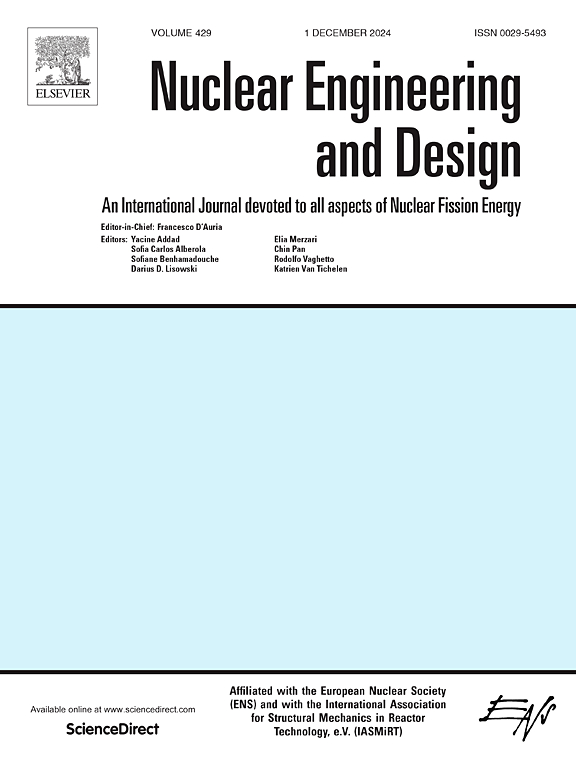压水堆腐蚀相关不明沉积物研究进展
IF 2.1
3区 工程技术
Q1 NUCLEAR SCIENCE & TECHNOLOGY
引用次数: 0
摘要
燃料包壳上的腐蚀相关不明沉积物(CRUD)严重影响反应堆的安全性和经济性。本文从压水堆CRUD的形成、性质和后果等方面对已发表的文章和公开的技术报告进行了综合综述,旨在更好地理解和预测这一复杂的问题。CRUD的形成是一个涉及可溶物质热力学和不溶物质动力学的物理化学过程。原生水化学、热水力参数、金属表面形貌等局部条件的变化会影响CRUD的成分和多尺度结构等性能。多孔CRUD中含硼化合物对中子的吸收导致轴向功率分布异常,这与毛细管流动、传热、溶质输运以及化学反应有关。本文还讨论了减少CRUD沉积的潜在策略,如水化学控制、化学净化、超声波清洗和涂层。目前最具吸引力的CRUD预防方法是精细控制水化学的注锌方法,从科学和生产的角度来看,涂层方法将是另一个有吸引力的CRUD预防方法,因为可以开发出事故耐受燃料(ATF)。本文章由计算机程序翻译,如有差异,请以英文原文为准。
Review on corrosion-related unidentified deposit of pressurized water reactors
Corrosion-related unidentified deposit (CRUD) on the fuel cladding is detrimental for nuclear reactor safety and economy. This paper provides a comprehensive review of published articles and disclosed technical reports concerning CRUD of pressurized water reactors in terms of its formation, properties, and consequences, which is intended to better understand and predict this complicated issue. The formation of CRUD is a physicochemical process involving the thermodynamics of soluble species and kinetics of insoluble particles. Changes to the local conditions, such as primary water chemistry, thermal hydraulic parameters, morphology feature of metal surface, affect the properties of CRUD including ingredients and multi-scale structures. Abnormal axial power distribution occurs due to the neutron absorption by boron-containing compounds in porous CRUD, which is related to the capillary flow, heat transfer, solute transport as well as chemical reactions. This paper also discusses the potential strategies to mitigate the CRUD deposits, such as water chemistry control, chemical purification, ultrasonic cleaning and coating. The most attractive candidate for CRUD prevention at current stage is zinc injection approach under elaborate control of water chemistry, coating approach will be another attractive candidate for CRUD prevention as development of accident tolerant fuels (ATF) from both scientific and manufactural perspectives.
求助全文
通过发布文献求助,成功后即可免费获取论文全文。
去求助
来源期刊

Nuclear Engineering and Design
工程技术-核科学技术
CiteScore
3.40
自引率
11.80%
发文量
377
审稿时长
5 months
期刊介绍:
Nuclear Engineering and Design covers the wide range of disciplines involved in the engineering, design, safety and construction of nuclear fission reactors. The Editors welcome papers both on applied and innovative aspects and developments in nuclear science and technology.
Fundamentals of Reactor Design include:
• Thermal-Hydraulics and Core Physics
• Safety Analysis, Risk Assessment (PSA)
• Structural and Mechanical Engineering
• Materials Science
• Fuel Behavior and Design
• Structural Plant Design
• Engineering of Reactor Components
• Experiments
Aspects beyond fundamentals of Reactor Design covered:
• Accident Mitigation Measures
• Reactor Control Systems
• Licensing Issues
• Safeguard Engineering
• Economy of Plants
• Reprocessing / Waste Disposal
• Applications of Nuclear Energy
• Maintenance
• Decommissioning
Papers on new reactor ideas and developments (Generation IV reactors) such as inherently safe modular HTRs, High Performance LWRs/HWRs and LMFBs/GFR will be considered; Actinide Burners, Accelerator Driven Systems, Energy Amplifiers and other special designs of power and research reactors and their applications are also encouraged.
 求助内容:
求助内容: 应助结果提醒方式:
应助结果提醒方式:


